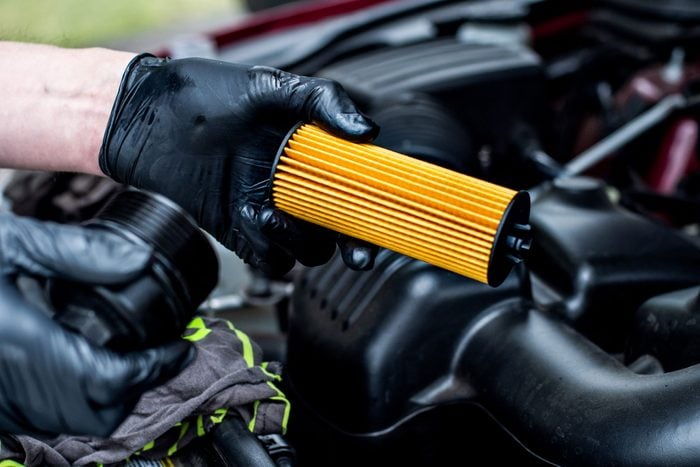How To Choose the Right Oil Filter for Your Car
Updated: Mar. 26, 2024

Keep your engine running cleaner and longer by choosing the right oil filter.
Choosing the right oil filter for your car may seem like a daunting task when met with rows upon rows of filters at your local auto parts store. The next time you’re wondering, “What oil filter do I need?”, know that your vehicle will only accept one type and often only one size filter, so the only choice left is between levels of performance quality. This is still an important decision. According to Jeff Wang of VSARS Filters, the quality of the filter you choose should not only depend on the type of vehicle you drive but, more importantly, how you drive it.
For example, a heavy-duty truck needs a filter that can handle high temperatures and the demanding rigors of a work vehicle. On the other hand, your modern small car that drives to the grocery store once or twice a week doesn’t need something so heavy-duty. A less expensive filter with a higher flow rate will be fine, especially if you change your oil at the recommended intervals.
On This Page
What Oil Filter Do I Need?
If you are a casual driver, a basic oil filter will service your vehicle just fine. Your filter should be heavy-duty if you do more extreme driving or towing. Consult your owner’s manual or quickly search the internet to find your filter part number. That number can then be cross-referenced with all filter brands to find the appropriate filter and correct fitment.
What Does an Oil Filter Do?
Oil filters protect the engine from harmful particles created by normal wear and tear. While these particles are small — almost microscopic — if allowed to accumulate and circulate through the engine, they would clog up the internals of an engine over time and cause premature failure.
Types of Oil Filters
Oil filters are classified in two ways — primary and secondary. All primary oil filters are considered “full flow” filters. This means all the oil in the engine will be routed through the filter all the time. A secondary oil filter can be added for extreme conditions, but this is not something most passenger cars will have. Secondary filters are used to provide additional filtering in heavy-duty or performance vehicles.
Spin-on filter
The most common primary oil filter type is the spin-on filter. While they come in many different sizes, they all have internal threads that mate to the oil filter port on the engine. They have a built-in gasket and are easily changed with the right-sized oil filter wrench.
Cartridge filter
Many newer engines use a cartridge filter instead of a spin-on design, although these are still not as common as spin-on filters. This type of filter often has additional parts such as O-rings and anti-drain-back valves, which must also be serviced when changing the filter media.
Do Different Types of Oil Require Different Types of Oil Filters?
No. All commercially available oil filters are able to handle any type of engine oil, whether it’s conventional, synthetic blend or full synthetic.
How Often Should You Change Your Oil Filter?
Change your filter with every oil change, which is between 3,000 and 5,000 miles for most engines. Some modern synthetic oils claim to be able to extend mileage between oil changes, and depending on your driving habits, this can be true. However, Jeff warns that if you only change your synthetic oil every 10,000 miles, research and ensure your filter can handle longer intervals.
How to Install an Oil Filter
Installing a Spin-on Filter
Clean the mating surface on the engine with some brake cleaner and a shop cloth. Dip your finger in clean oil and rub the gasket material on the filter. Spin it on until the gasket contacts the mounting surface and hand-tighten the filter until you’re not able to spin it anymore. If you can’t get a good grip with your hand, use a strap-style oil filter wrench to help, but be careful not to over-tighten.
Installing a Cartridge Filter
Loosen the retaining nut and remove the cap. Always note the location of the O-ring as you remove the cap and replace it with the new one provided. Some filters will have more than one O-ring. If the O-rings have notches to help align it, ensure they are re-installed properly otherwise a leak could occur. Lube the O-ring(s) with oil, and use a torque wrench set to the manufacturer’s specifications to tighten the cap.
Follow the Manufacturer’s Recommendations When Choosing an Oil Filter
Oil filters are application-specific. Don’t think you’re getting better filtration by substituting a larger filter just because it fits the threads on your engine. The gasket might be a different size, its filter media may have a different flow rate or the bypass valve may act differently than the correct filter. Don’t second-guess the filter manufacturer.
About the Experts
Jeff Wang is an expert in automotive filtration technology specialist who focuses on oil filters and fuel filters as the global sales director at VSARS Filter.
Jay Cork has been wrenching on cars for longer than he has been able to drive them (legally).
